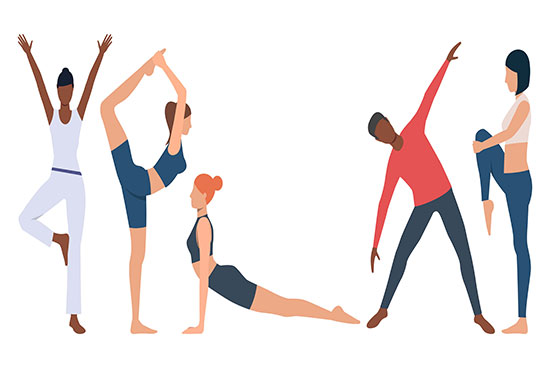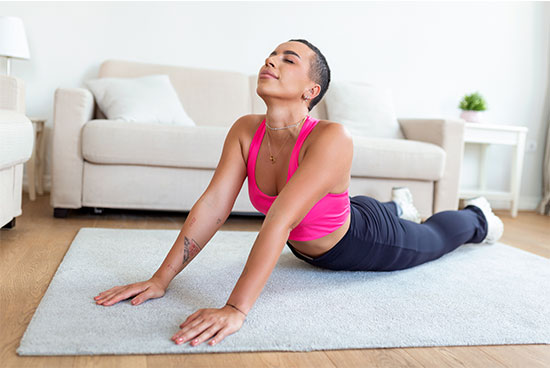Staying fit is the prime concern for all, so to stay fit we need to gain flexibility which will play a pivotal role in our overall health. Being flexible is an important part of fitness and overall health. The more flexible you are will decrease greater the chances of injury. Whether in sports or daily exercise regimes, flexibility plays a very important role and hence can only be attained while performing stretching exercise before starting any workout. Daily activities would be much more challenging without the ability to bend over, twist, or squat. However, incorporating a stretching program into your daily routine will allow you to increase your flexibility and range of motion. You can also improve performance in sports and daily tasks. Stretching can help prevent injury and decrease pain associated with muscle tightness.
Suitable Time to Stretch
There is no fixed time to stretch. Studies have suggested that at least two to three weekly stretch sessions that target each major muscle group should be incorporated by every individual before starting any workout regime or after having a sedentary position for long hours.
- Before working out – Five to 10 minutes of dynamic stretches before every workout should be enough to get you warmed up.
- Post Workout – Slower, more relaxing techniques like passive and static stretching are great for after a workout. These methods lengthen the muscles and connective tissues and help your body return to a balanced state known as homeostasis, meaning your body temperature, heart rate, and blood pressure all return to a state of normal.
- Sedentary position for a long time – Stretching periodically throughout the day can ease muscle tightness if you tend to sit or stand in the same position, such as if you work in front of a computer for long hours, or have been sitting in a car or on an aeroplane for a while, or if you work a service job and are on your feet for several hours.
 Health Benefits of Stretching
Health Benefits of Stretching
There are many health benefits of stretching that does wonders if we incorporate it into our workout schedule.
- Increases Flexibility – Stretching increases muscle flexibility, which is needed to maintain a healthy range of motion in the joints. Flexibility may sound similar to mobility, but they are different in that flexibility is the ability of the soft tissues i.e. muscles, tendons and ligaments to stretch without assistance, whereas mobility is the ability of the joint, to move through its full range of motion.
- Enhances Mobility – It’s important to work on your mobility and flexibility if you sit a lot during the day, or even if you don’t live a sedentary lifestyle. Even when we are up and about, many of us tend to limit ourselves to a narrow range of motion, relying a lot on certain muscles and not calling on others at all. When we stick to a handful of positions, this puts extra tension on certain muscles and can throw our muscles, bones, and joints out of ideal alignment.
- Better Range of Motion – Getting into the habit of stretching exercise will allow you to achieve a better range of motion throughout your joints and muscles. Stretching the soft tissues in the back, legs, hamstrings, and hip flexors can improve joint range of motion in the spine, which helps relieve back pain.
- Reduces Chances of Injury – Injury is inevitable and it always appears either in a minor or major stage. To prevent injuries at the time of workout, stretching exercise is necessary to be conducted before starting any workout. Mobility and flexibility work also prevents injury during exercise and improves your ability for any workout.
 Best Stretching Exercises for your home
Best Stretching Exercises for your home
1.) Lower Back Stretch
This stretching exercise is considered one of the best to prevent back pain. Below are the ways to perform it.
How To Perform
- Stand with feet hip-width apart.
- Bend your knees, hinge forward at the hips, and place your hands on your knees.
- Your pelvis, back, and neck should be in a neutral position so that your body forms a straight line from the top of your head to the top of your glutes.
- Without losing that neutral position, reach your left hand toward the right foot, allowing your left knee to bend and the right knee to straighten so you can shift your hips.
- Actively reach toward your foot while driving the right hip back and the left hip forward.
- Pause briefly before returning to the starting position. Repeat on the opposite side.
- Keep alternating sides for 30 to 60 seconds or 4 to 6 repetitions.
2.) Hamstring Stretch
This stretching exercise is considered one of the best to consider. It is certainly the great one before your bike ride or runs. For those working out their calves in the gym, try this after your workout.
How To Perform
- Stand completely straight (stand tall) with your arms to your side.
- Bend over until you’re in a U-shape.
- Grab the back of your ankles.
- Hold for a minute or two.
3.) Sitting Shoulder Stretch
This stretching exercise is considered one of the best to prevent shoulder pain. This one attacks all of the tension in your upper back. It can also be a great way to relax after a stressful day. The shoulders and back are huge muscle groups, so this one will feel great.
How To Perform
- Sit with your butt on the ground and your heels planted.
- Put your hands together behind your head.
- Squeeze your shoulder blades together and lower your clasped hands as far down to your tush as possible.
- Hold it for 5 seconds.
- Repeat these steps a dozen times.
4.) Lunge Stretching
This stretching exercise is widely considered for flexibility. Your quads and glutes are subject to a lot of knotting they are the biggest muscle group in the body. Don’t forget to stretch them after a run.
How To Perform
- Kneel on one of your knees. Plant the opposite leg’s foot in front of you.
- Lean forward, it will push your hips closer to the floor.
- Hold it for a minute.
- Switch knees and do the next leg.
5.) Calf Stretch
Here is another isometric stretching exercise which will be a boon for your calf muscles.
How To Perform
- Begin standing in front of a wall at arm’s length from it with your feet hip-width apart.
- Place both hands flat against the wall. Step the right foot back so it’s straight, with your heel flat on the floor, bending your left knee as needed.
- Keeping both feet pointed forward, gently press your upper body toward the wall until you feel a stretch in your back calf and heel.
- Hold for 30 seconds and then begin pushing the ball of your back foot into the ground like you’re stepping on a gas pedal.
- Build the pressure slowly and continue until it feels like a 5 or 6 out of 10 on the intensity scale.
- Hold at that intensity for 10 seconds and then slowly relax the foot.
- Hold the stretch for another 30 seconds and see if you can go deeper into the stretch.
Disclaimer:
The information contained in this article is for educational and informational purposes only and is not intended as a health advice. We would ask you to consult a qualified professional or medical expert to gain additional knowledge before you choose to consume any product or perform any exercise.








